You may not have much freedom of choice when it comes to picking the dates for your holiday. However, if you are retired, or if you have a flexible job, or if you don’t have any kids – you may be able to choose freely. We’ve lived in the Cairngorms for nearly 20 years now. Over the last 20 years, we’ve noticed highlights in every season. We’ve picked a few out for you, which might help you decide when to come and visit.
February is perceived to be the best of all the winter months to come to the Cairngorms. This perception is helped by the fact that the schools have a break in mid-February. Many families utilise this time to go on a ski holiday. In Scotland, February is not always the best time to catch the snow conditions. There is usually skiing available. Some years conditions can be pretty thin in February but March and April have phenomenal snow cover. January & February can also be affected by winter storms bringing winds well in excess of 100 mph. However, when the weather does play ball, you can have the most glorious winter day out with views of over 50 miles in crystal clear air.
If you do plan to visit the area with your family during the half-term weeks in February, we would strongly advise that you prebook your accommodation
If you think it would be advisable to join a guide at this time of year, check out these options:
Classic Winter Cairngorms – a guided winter walking holiday
5 day winter skills course – to improve your own techniques and safety in the hills
It’s definitely still winter in March but the daylight hours have already extended. You don’t have to make an early retreat from your hike, but neither do you have to rise unsociably early. In mid-winter, early rising is necessary to get to the start of your route so that you can finish it before dark.
It’s often a good time to go out for a Snow Hole Expedition as the snow cover will have accumulated significantly at this point, most seasons. We do run other winter expeditions between January and March. These expeditions require a high level of fitness. They are the most strenuous and rewarding of the trips we do.
Trips include: The Cairngorm 4000ers in winter, the Southern Cairngorms Winter Odyssey, Winter Affric Shangri-La, Loch Nevis Winter Expedition, Knoydart Winter Walking. For full details contact us.
Prime time for birdwatchers as you may have seen on BBC Springwatch. This is when the Ospreys return to Loch Garten along with the beginning of the Spring migrations for most of our summer visitors. It’s also your best opportunity to see a Capercaillie or Black Grouse lec. The RSPB open up the Osprey hide at Loch Garten at 5.30am to help keen birdwatchers see the Capercaillie.
April and May can be quite cold months here. It is still common to have snow fall down to village level in April. Fortunately the sun is that bit stronger than mid winter. So when you’re in a sunny spot it will feel pretty warm. It’s a great time to be out in the hills as the air is often clear, the daylight hours are a wee bit longer and the sun can be out for long periods Watch out for the April showers which often fall as snow or sleet rather than rain.
April/Easter often mark the start of the tour season here in the Highlands. Pre-booking for accommodation, especially during the school Easter holidays is highly recommended.
When the weather is right in April, you can get very warm when out hiking in the Cairngorms.
Snow patches remaining on the high hills can mean that sun burn is a serious risk due to the reflection of sunlight on the snow.
The weather can change incredibly in April – you always need to be prepared for any season. It can go from this:
To this within 24 hours:
April is generally when the caravans start to visit the area. The campsites open up again. There are more possibilities to get outdoors without worrying about too much snow everywhere.
We’re going to run our first Outlander Adventure Experience in April. How about it? A chance to get out in the outdoors – try a piece of the experience Clare and Jamie would have lived here in the Highlands.
You’re also more likely to be able to find tourist sites open once April starts. You can visit places like:
– all without travelling more than 1hr from Fraoch Lodge.
This is a fantastic time for the wildflowers and also a good time to spot birds such as eagles and Scottish crossbills. We’ve had families of crossbills visiting the garden in June. It’s not quite such a good time for going to the wildlife hide to spot the nocturnal night life as dusk is so late in the day, if it arrives at all!
Weather can be variable in June. It has been known to snow on the high mountain tops. Some people have skied on Cairngorm on mid-summer’s day – more for publicity than good quality skiing though.
Don’t forget June 21st is mid-summer’s day – in the Highlands, including the Cairngorms, this means the sun hardly sets. June is a great time to get all those Munros with long walk-ins done. Watch our for the June Monsoon though.
We have in the past couple of years had glorious weather in July. We often have a week of clear skies and warm weather with temperatures in the high 20s or low 30s. It is by no means guaranteed. The better weather is usually earlier in the month, before most of the English schools are out for their holidays.
August is a great month to catch the Highland Games but is the busiest for all accommodation businesses across the Highlands. Pre-booking is almost essential at this time of year unless you want to be trawling round the country at 9pm still looking for beds. August can also be very showery with the highest chance of thunderstorms
Bonus: glorious colours of the heather out in full bloom turning the hills purple.
Top tip: Most of our local Highland Games take place between mid- July and mid-August. Check the dates: Abernethy Highland Games (2nd Saturday in August), Newtonmore Highland Games (1st Saturday in August) etc and make sure if your visit coincides with the Games that you pre-book your accommodation.
Some of our most reliable warm, dry weather happens in September. In addition, the end of the Highland Games season can be experienced by attending the Braemar Gathering at the beginning of the month.
Some of the best edible mushrooms start to appear in September. If you’re not familiar with the area, join one of the guided ranger walks with an expert to start to get your eye in. Make sure you follow the mushroom picking code.
Blairgowrie Walking Festival
Cairngorm Adventure Triathlon
Grantown Try Tri
Glenmore 24 Trail Race
Loch Insh Highland Splash-In – first waterplane event to be organised by the model flying club in Scotland, now on the 31st consecutive event.
Check out the colours and light in October. It is the perfect time for a photography extravaganza.
Quieter times and shorter days but with the right weather conditions. It is the perfect time to get those early morning and later evening quality light shots with a touch of winter, if the first of the snow showers have arrived.
Another delightful and very attractive spring arrival to our high mountains is the Dotterel. Like the first snows, my first sighting each spring is always a “marker” in the mountain year. Both sexes sport a distinctive pastel chestnut/orange breast and above the eyes a crown of dark feathers bordered by a broad white strip. Up close they are a very striking bird.
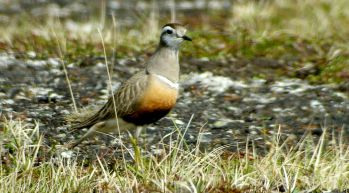
Photo Caption: A dotterel – often seen in the Spring in the high Cairngorms when out hiking with Scot Mountain Holidays
Photo Credit: Åsa Berndtsson
Like the Ring Ouzel and the Wheatear, it winters in Morocco. They migrate in groups known as ‘trips’ and then move into their territories as the snow thaws and with nesting beginning in mid May. They nest is a shallow scrape in the ground lined with moss and lichens. With the Dotterel the roles are reversed, they are one of only 22 species worldwide where the male does all the incubation of the eggs. He often does all the rearing of the young as well whilst the female may well move onto another territory, sometime as far as Norway, and mate again. In Scotland it nests above 700m in the Cairngorms and quite often well above 1000m and down to 550m in NW Sutherland which corresponds with the descent of the alpine vegetation zone.
Early in the season when the birds have just arrived they will often allow you to get remarkably close – to within 4 feet on one occasion! This having been said they are susceptible to disturbance and despite there striking plumage are often well camouflaged against the pink granite and gravel of the Cairngorm Plateau. To the unaware hillwalker with his/her head down you may only be aware of them once it’s too late. Be alert to the possible presence of this bird when you’re on the high tops and if you do spot any movement ahead, immediately stop and check it out. If it is a Dotterel retreat back a little as the movement you spotted may have been as a result of the bird feeling threatened. If the bird is giving you the “broken wing” treatment i.e. flashing a droopy wing, again it’s a sure sign it feels threatened. Hopefully you have some binoculars to get a proper look at the wonderful mountain plover bird. If you have a dog with you it is best kept on a lead despite the expanse of the plateau appearing to be an ideal place to let “meg” have a run around.
Photo Caption: David Dickerson taking in the vista before him when hiking across the Cairngorm 4000ft peaks with Scot Mountain Holidays
Photo Credit: Scot Mountain Holidays
The broken wing treatment is most likely to be exhibited when the adults are with their young. The adult uses the impression of being injured and hence the prospect of an easy meal for any predator as a decoy to lead any threat away from the chicks.
We quite often spot this bird on a number of out walking trips which take in the higher peaks of the Cairngorms: Cairngorm 4000ers Gentle Giants. Complete Cairngorms Wild Cairngorms
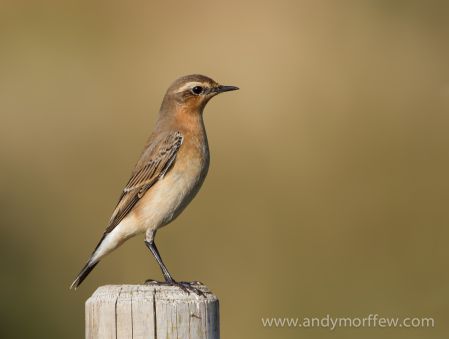
The Wheatear
Photo credit: Andy Morffew
If you go birdwatching near Aviemore, you’re bound to want to head up into the mountains. There are several species of bird you won’t find in your back garden which you’ll be on the lookout for. The Wheatear is probably one of them.
With the eyes on the ground and the mind on the conversation, the little Wheatear ahead of you flitting from one boulder to another can easily be missed. Take a closer look and it will reveal itself as a most striking little bird. A little bigger than a Robin, the most obvious feature of this bird is its white rump and tail. Its name has nothing to do with neither “wheat” nor “ears” but is a corruption of the words “White” and “Arse” by embarrassed Victorian’s. The male’s breast is of soft pastel tones of pink and bluff. The wings are black and its back sports a smart cape of grey. This is all topped of with a striking bandit like black eye stripe
It is one of the first to arrive in our mountains having completed a huge journey. The wheatear travels from sub Saharan Africa, across the Sahara, over the Atlas Mountains, the Mediterranean and up through Spain and France. It finally arrives in our mountains in April. On it’s migration it can cover up to 500 miles in a day. Not bad for a one ounce bird!! Some birds make a journey of 30 000km (18640 miles) – one of the longest migrating flights known.
They have one of the most extensive breeding ranges of any bird being found from Alaska to Iran. In Scotland they are often found on unimproved grassland between 300 and 800m up but have been found to be breeding on the highest ground in the Cairngorms at up to 1200m.
At one time in Sussex they were regarded as a delicacy and were trapped by shepherds for the restaurant tables of Lewes, Brighton and Eastbourne. Few birds now inhabit these parts due to loss of habitat but this is certainly not the case for the Scottish Highlands where the breeding population is estimated to be between 35 000 – 95 000 breeding pairs. They are one of our most common upland birds and one you are likely spot on your mountain journey.
Dotterel, Capercaillie, Crested Tit, Scottish Crossbill, Red and Black throated divers,
For details of private guiding for birdwatching opportunities try this page on our website.
If you would like to join a hiking group interested in wildlife watching opportunities try this itinerary in the Cairngorms National park.
Birdwatching in the Cairngorms: Ring Ouzel
Though we don’t claim to be wildlife guides or guides for birdwatching in the Cairngorms, Andy is always delighted to see bird life when he is out with walking groups.
“I was delighted to see my first Ring Ouzel of the season. This would be a great start to my High Mountain Wildlife blog.” I thought. “I saw the Ring Ouzel amoungst the Dwarf Mountain Pine in the Cairngorm Ski Area. If you come to stay at Fraoch Lodge, I’ll be able to explain exactly there I usually see these lovely birds and what time of year it would be best to see them.”
One of the treats of Scottish mountains in spring, particularly for birdwatching in the Cairngorms, is the arrival of the increasingly rare Ring Ouzel. The Ring Ouzel comes back from its wintering grounds of the mountains of North Africa in the spring. It’s the mountain equivalent of the Blackbird. Due to its scarcity, its remote high mountain living and it’s very flighty nature, it’s a hard one to spot. It is though, one of the first birds to arrive and one of the last to leave. We do come across it fairly frequently on our walking holidays especially as the Cairngorms National Park is a stronghold.
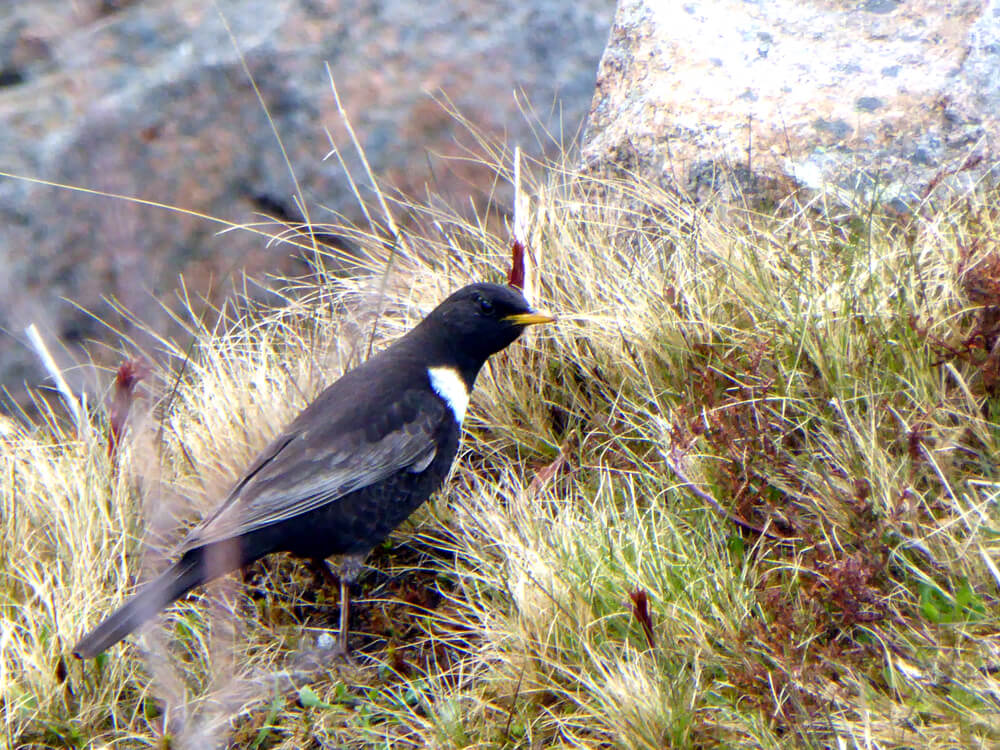
A male ring ouzel spotted in the Cairngorms
Photo Credit: Scot Mountain Holidays
The male is a very handsome black bird sporting a very distinct white bib or ‘gorget’ right across his breast. The female’s gorget is a far less striking brown being just a lighter shade than the rest of her dark brown body. Noticeably both sexes have a silvery sheen across the backs of their wings in flight and are a slender version of the common blackbird. They are very much a bird of open tree-less landscapes.
Their alarm call is a distinctive chac, chac, chac with their flight being low and direct. Their song is delightfully fluty and strong with it being composed of a few notes followed by a pause and then a few more different notes.
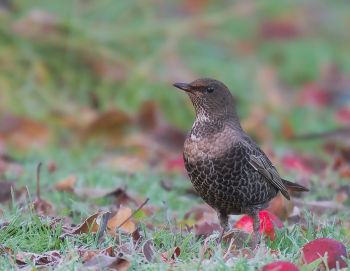
Photo Caption: Female Ring Ouzel
Photo Credit: Stefan Berndtsson
In massive environment of the mountains they can be a difficult bird to spot. They are often quite a vocal bird. Its song is probably the first thing that will alert you to its presence. It is quite similar to the common Blackbirds all be it at a slightly higher pitch. They also have the convenient habit of singing their pretty little tune perched on a rock. In the Cairngorms they are very much a bird of steep inaccessible rocky and cliff terrain.
Their numbers have been subject to a steady decline over the years. There’s also been a severe (at least 50%) contraction of UK breeding range over last 25 years. They are our least understood endangered species, being one of the 52 on the British Red List. Upland forestry is thought possibly to have had an effect on their breeding habitat whilst the loss of their winter juniper scrub habitat 1500m – 2500m up in the Atlas Mountains is also thought to be responsible.
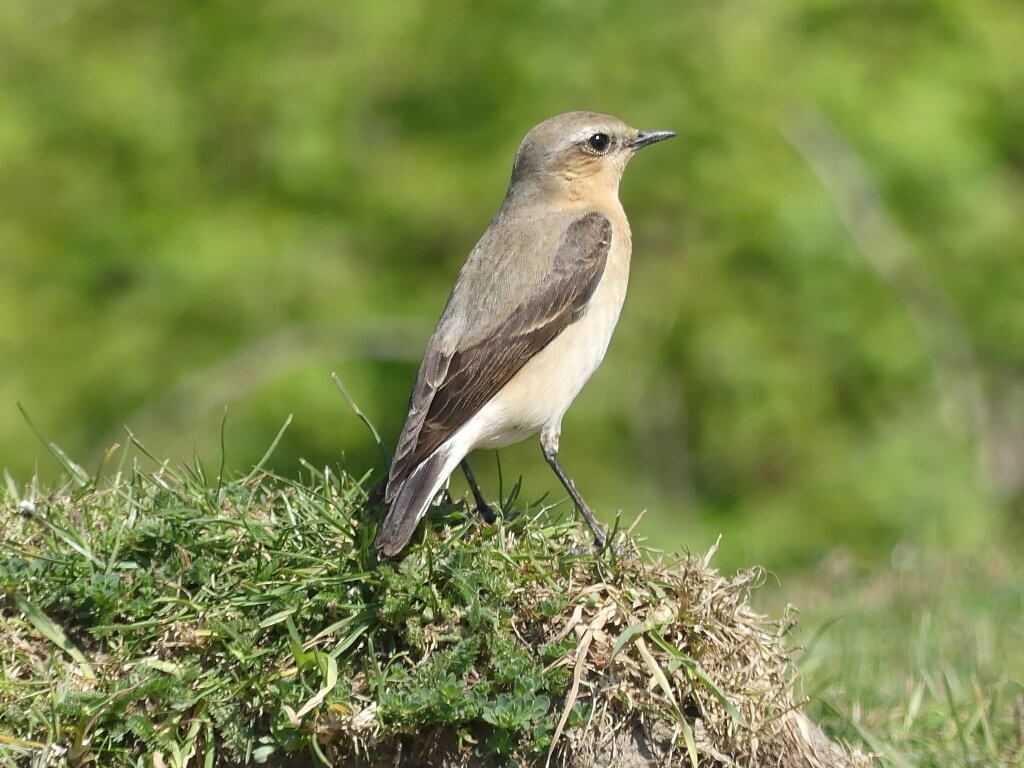
Wheatear: high wildlife in the Cairngorms
We’re back home now and managed to get a wee swim in this morning.
We’ve spent a lot of time discussing the training weekend. We both really enjoyed the very high level of your coaching skills. We learned a lot of theory but not so much that we can’t remember it and the practical aspect was also great especially the drills for running and swimming. We learned more about how to set up the bike and use the gears in one weekend than we have in years on our own! We also went into the pool session this morning with a greater sense of purpose than we have for a long time.
If I can now put on my ex-teachers hat, I think you are a natural teacher. You know your subject extremely well from both the academic and experience standpoints. Despite being an elite athlete you never talked down to us and never treated us like numpties. Carol was particularly pleased that you did not ignore her and direct your comments to me as has often happened with instructors in the past.Your delivery is informal and a good mix of fact and anecdote. You also listened well and acted on what you learned about us. We were apprehensive before the course that we would not be good enough to keep up but that was never an issue and you were constantly positive and reassuring. It was a privilege to work with you. I am sure that you will be very successful in your coaching career
By: Carol and Charles Davies, Mull
Carol and Charles are both now resident on Mull and regularly take part in 10k runs. In fact, they have been inspirational in putting together a group on Mull to run 10 x 10k runs to raise funds for a new hall on Mull. They also have a run booked on Iceland this year which will take place on the longest day.
Related blogs:
Triathlon training in the winter
Related products from Scot Mountain Training Camps
In the pipeline:
Boot Camps; 5 day triathlon training camp; Family friendly Triathlon camps; Triathlon pool based swim camps; Triathlon open water swim camps; Long distance triathlon camps … please contact us for full details if you’re interested in any of these proposed camps.
We are also planning to list some open dates for bookings of 3 or more people for the camp of their choice. Please check the website for availability.
All content © Copyright Scot Mountain Holidays 2024
Responsive web design by Summit Web Solutions